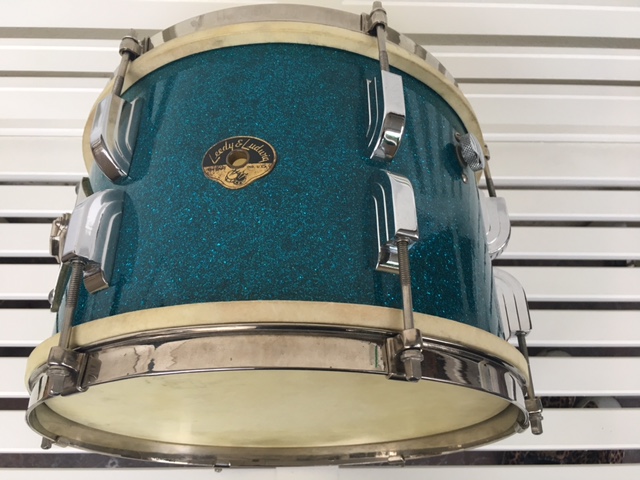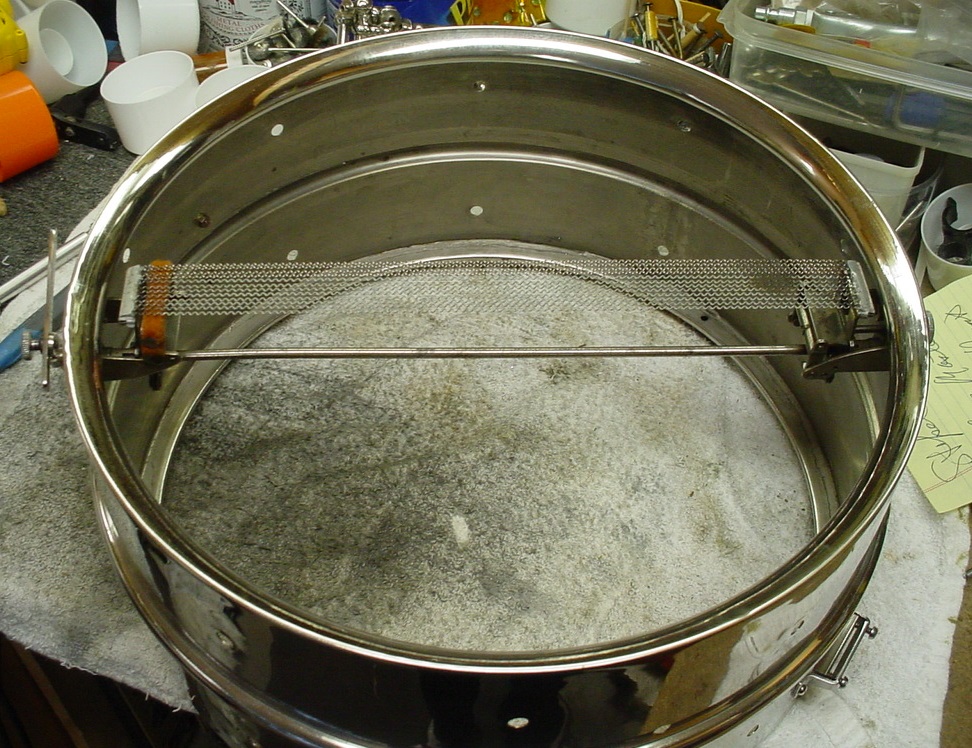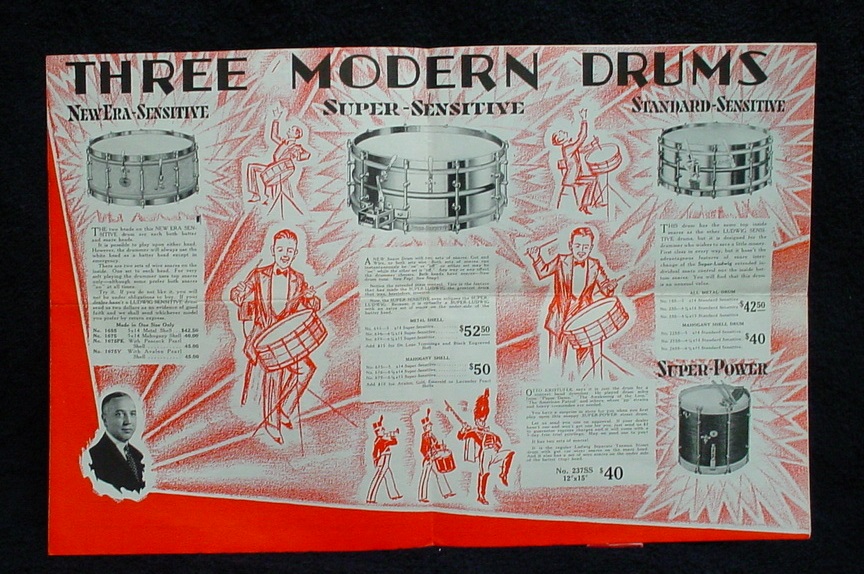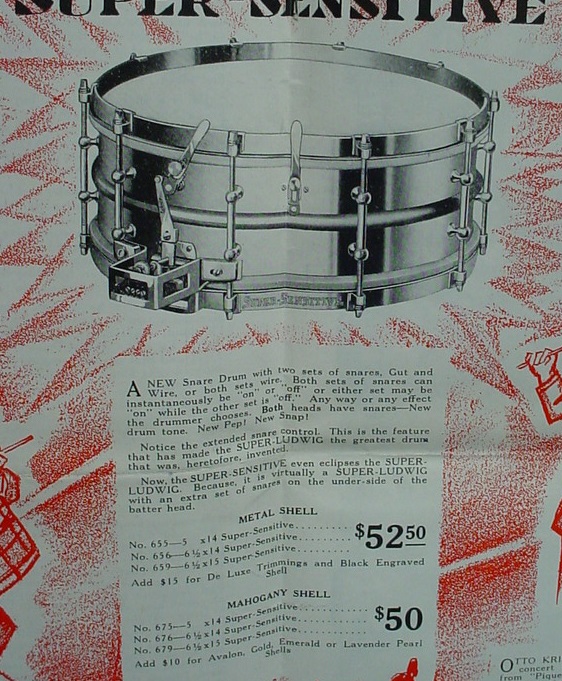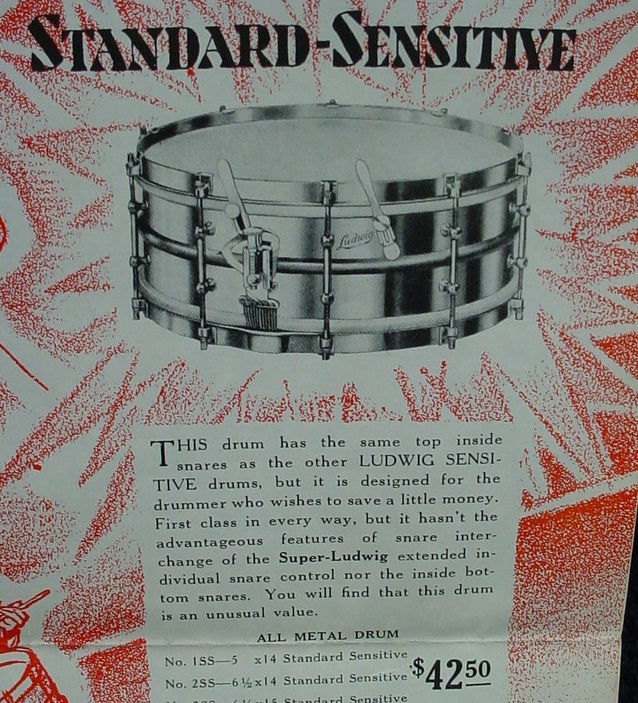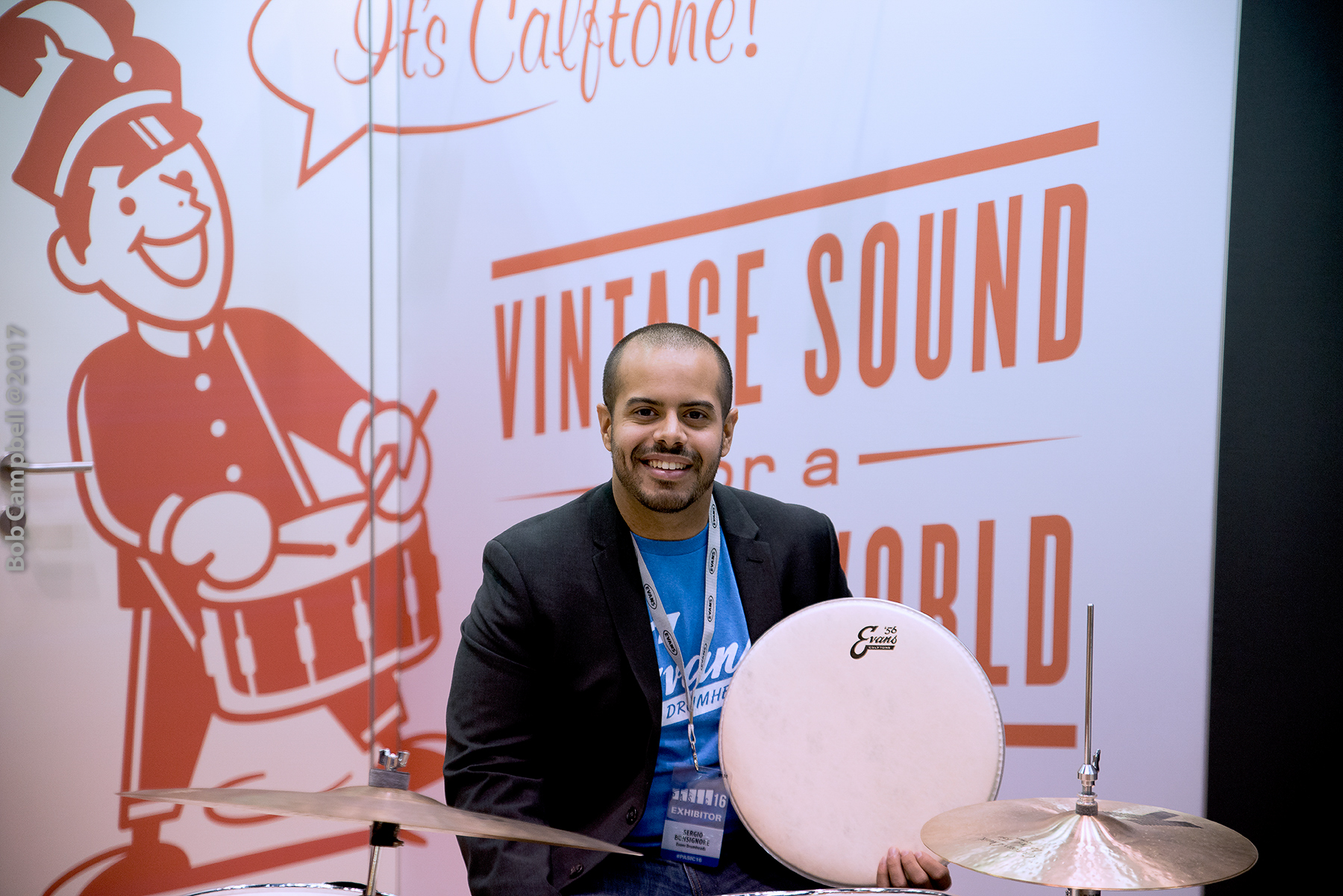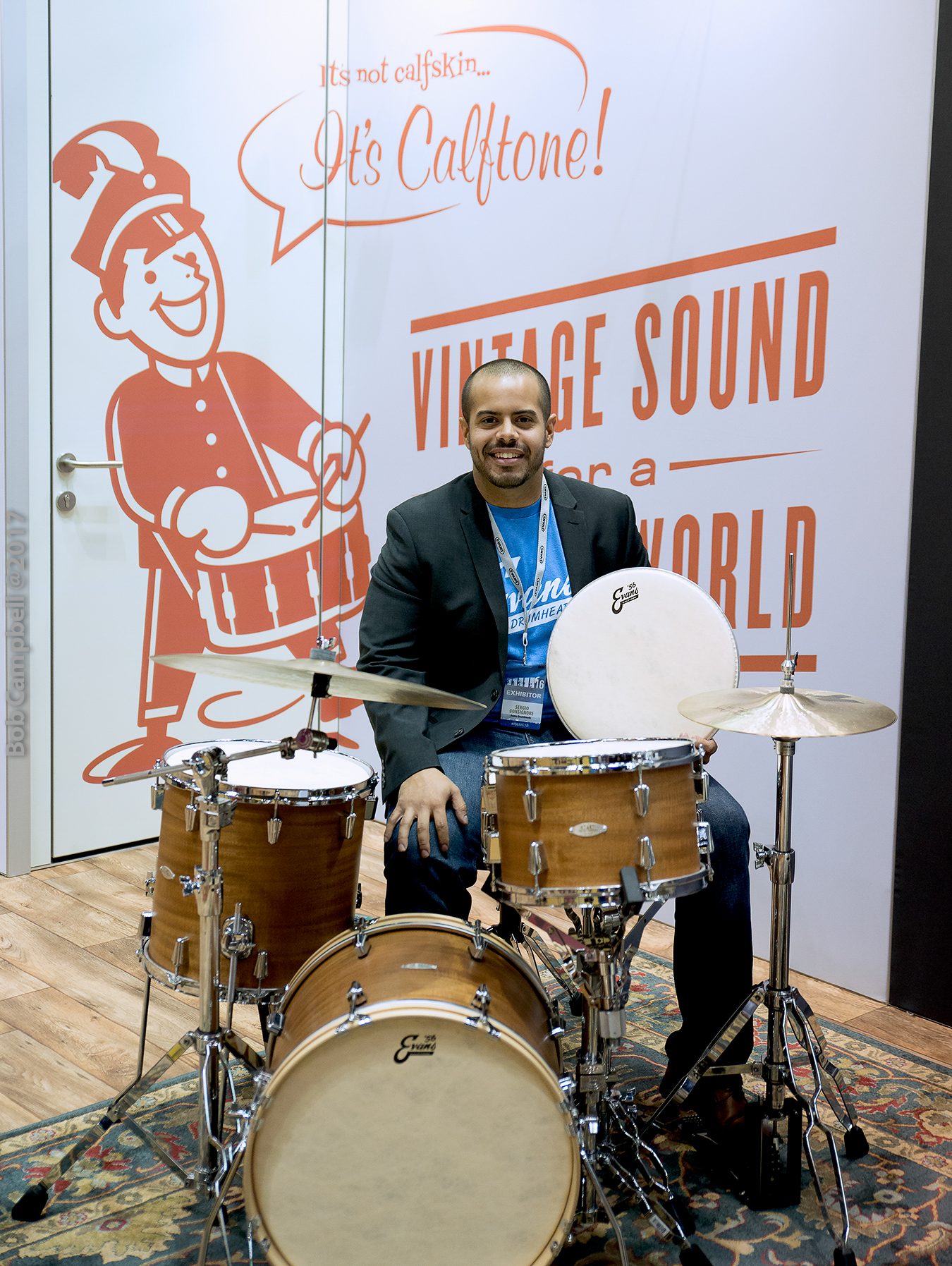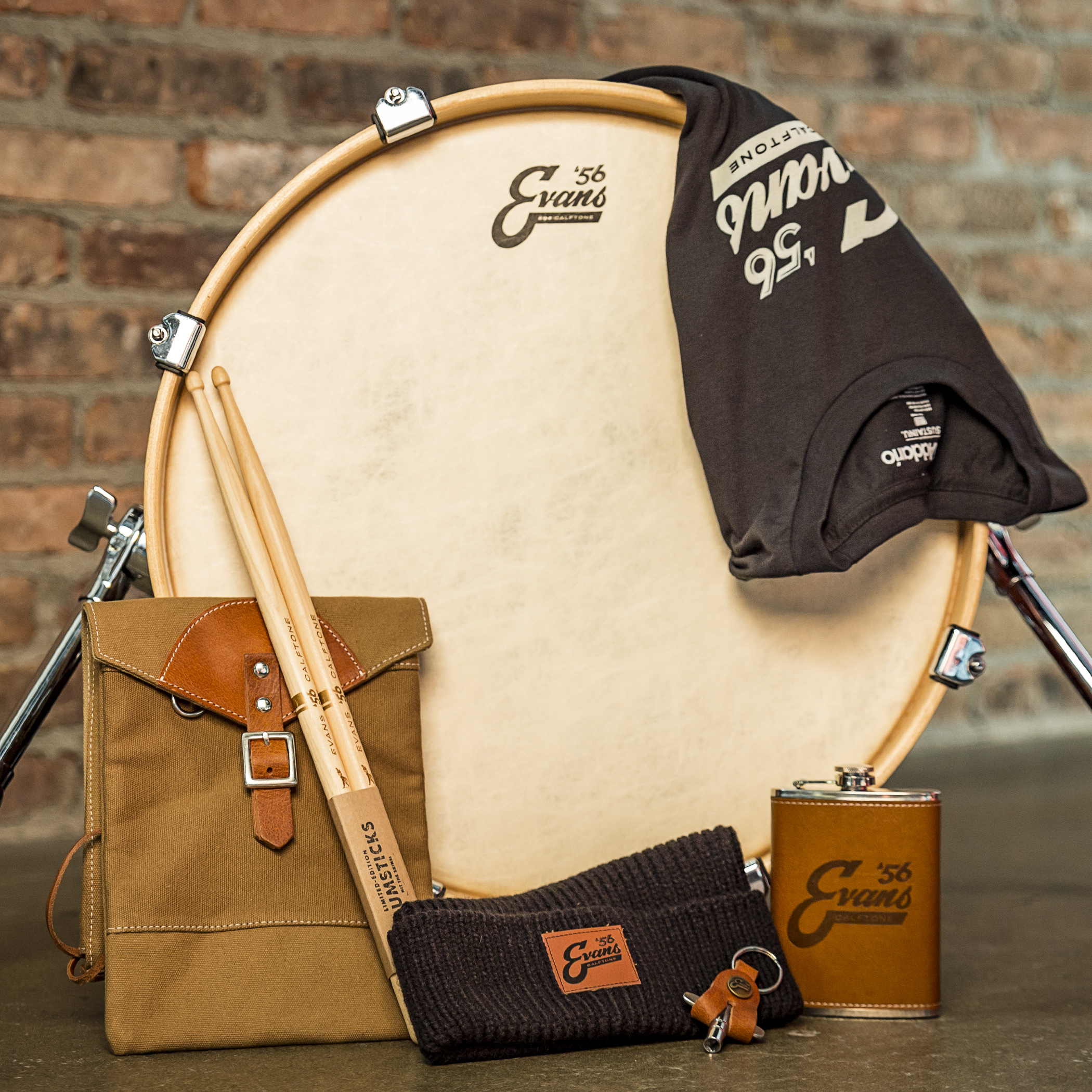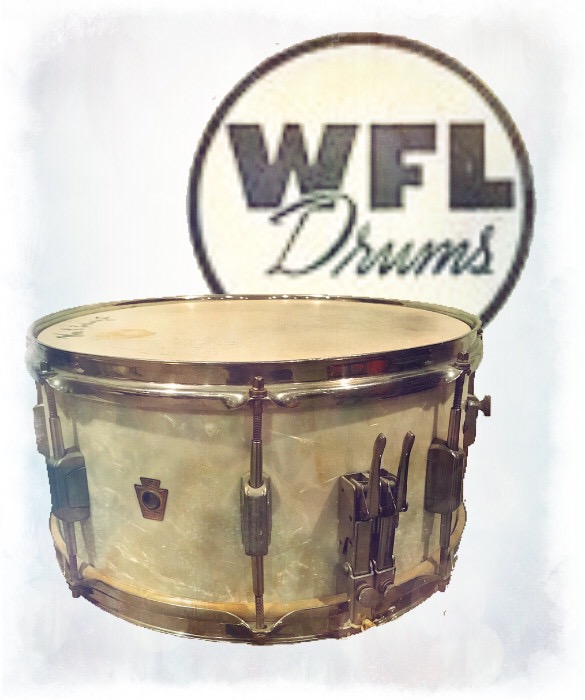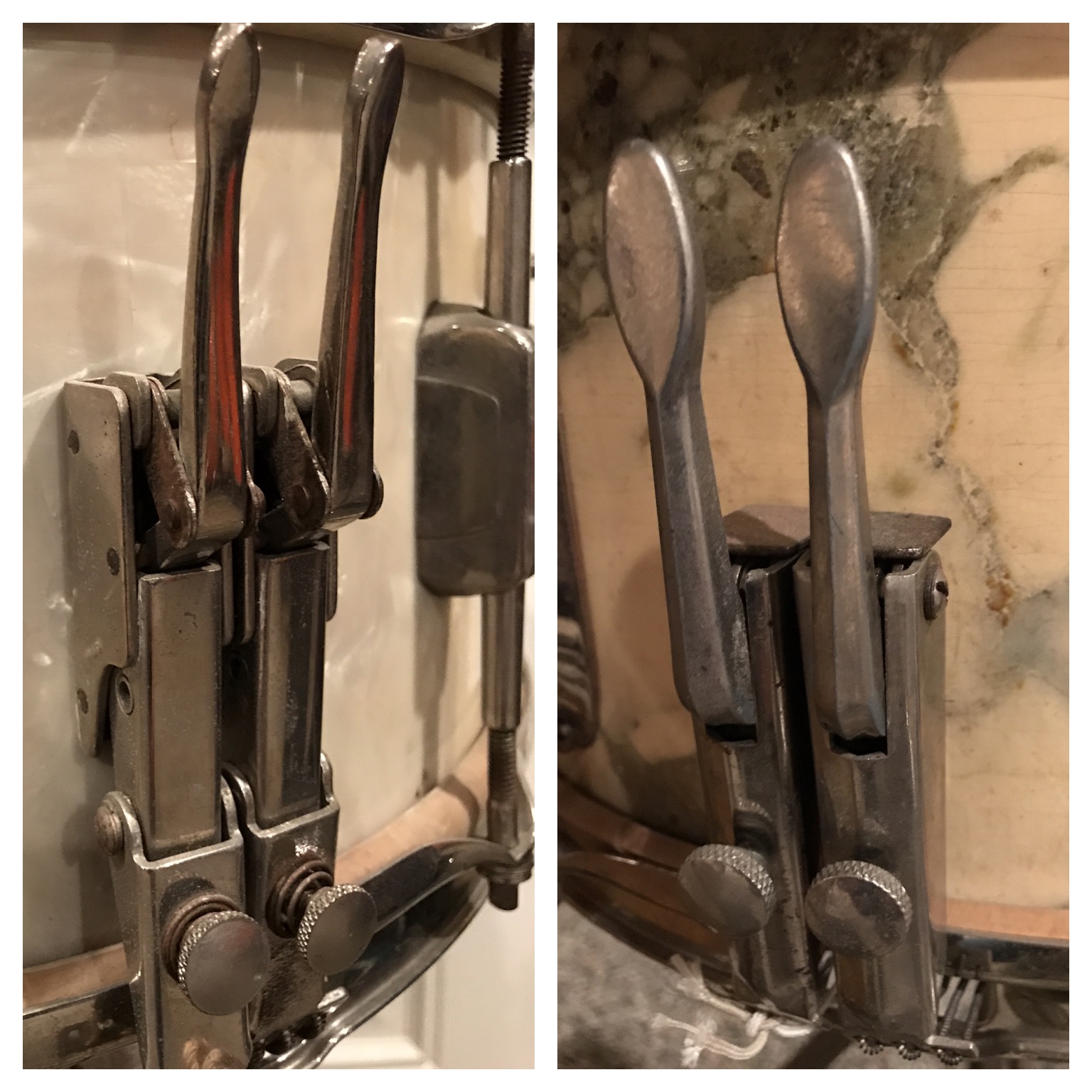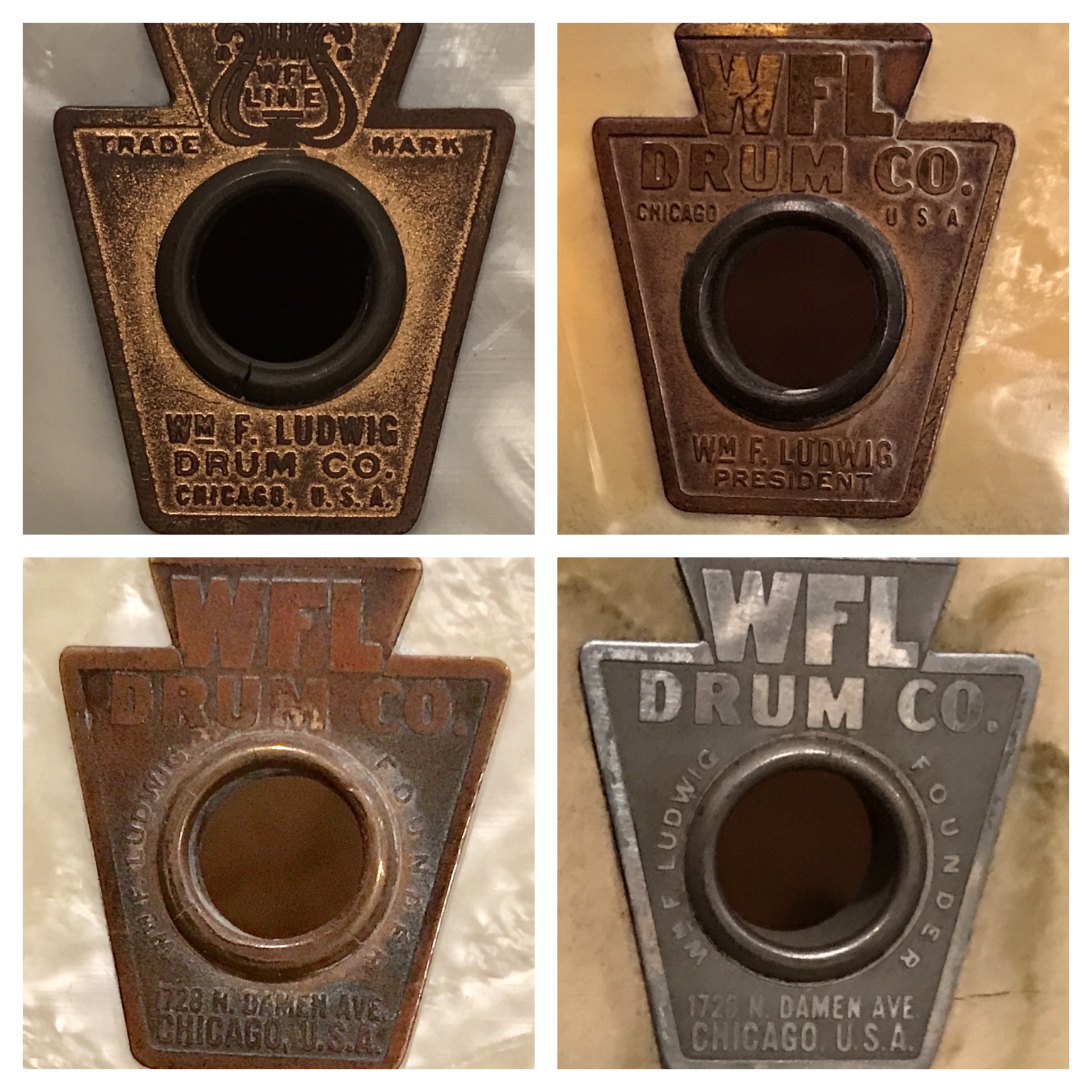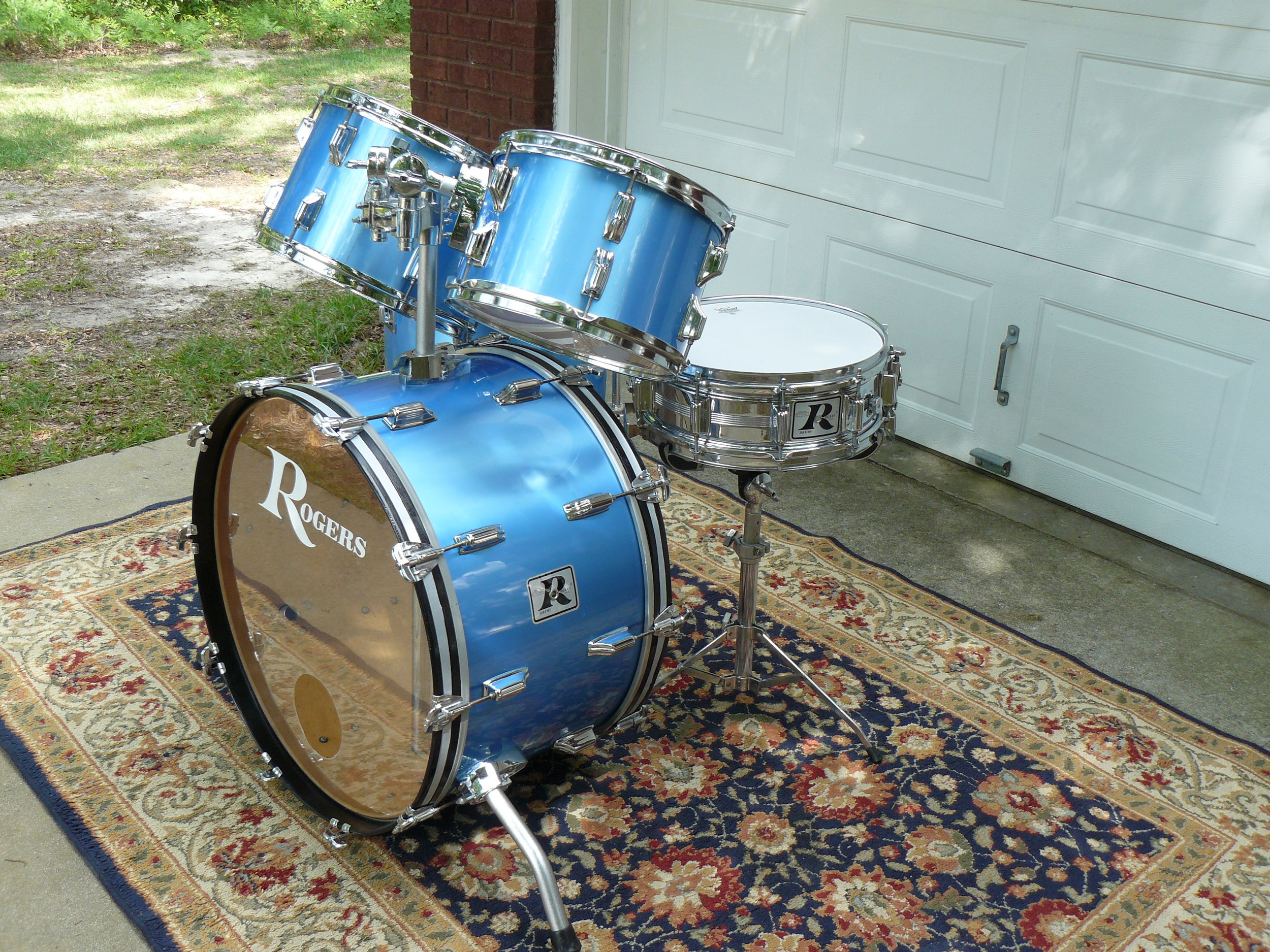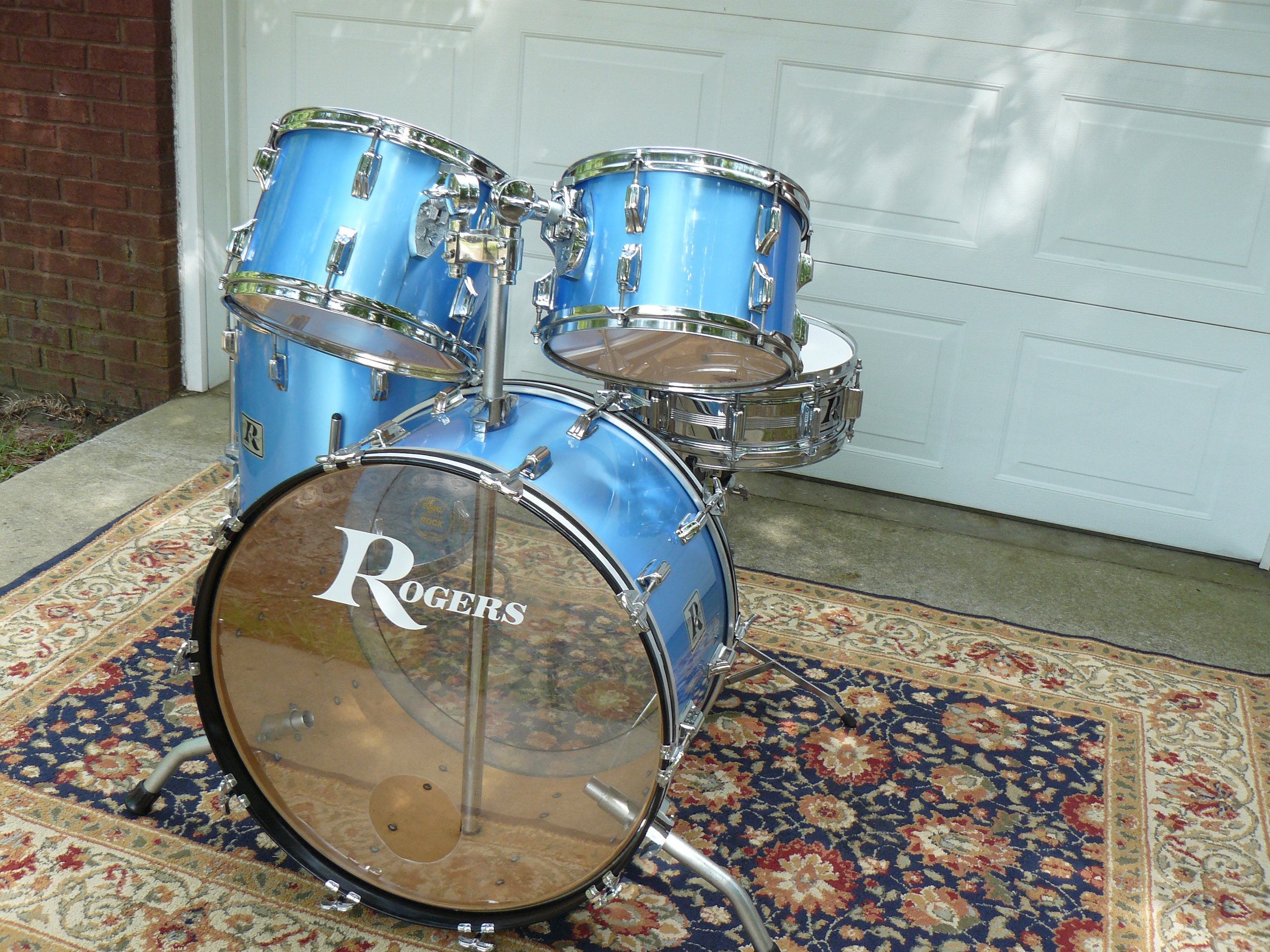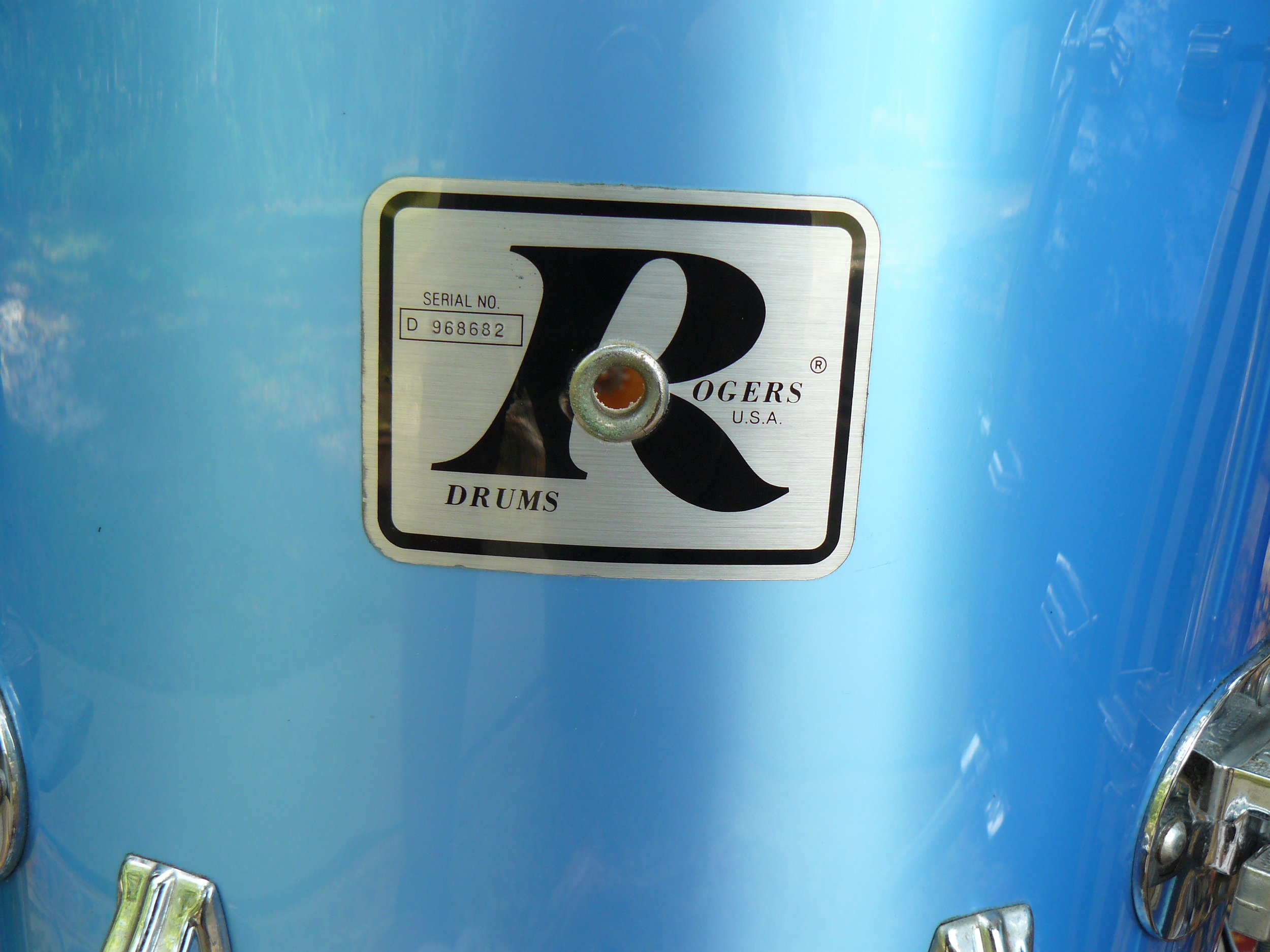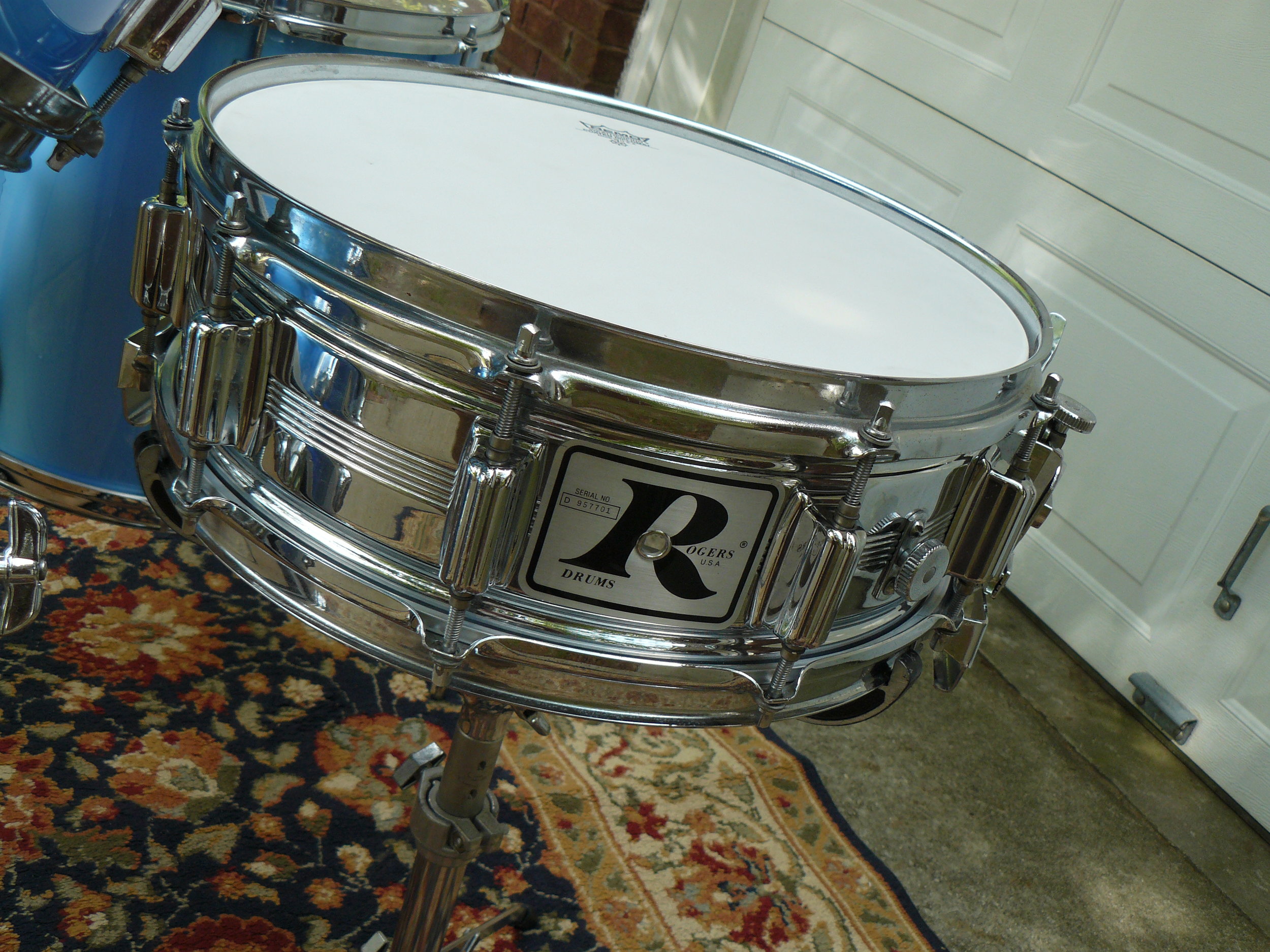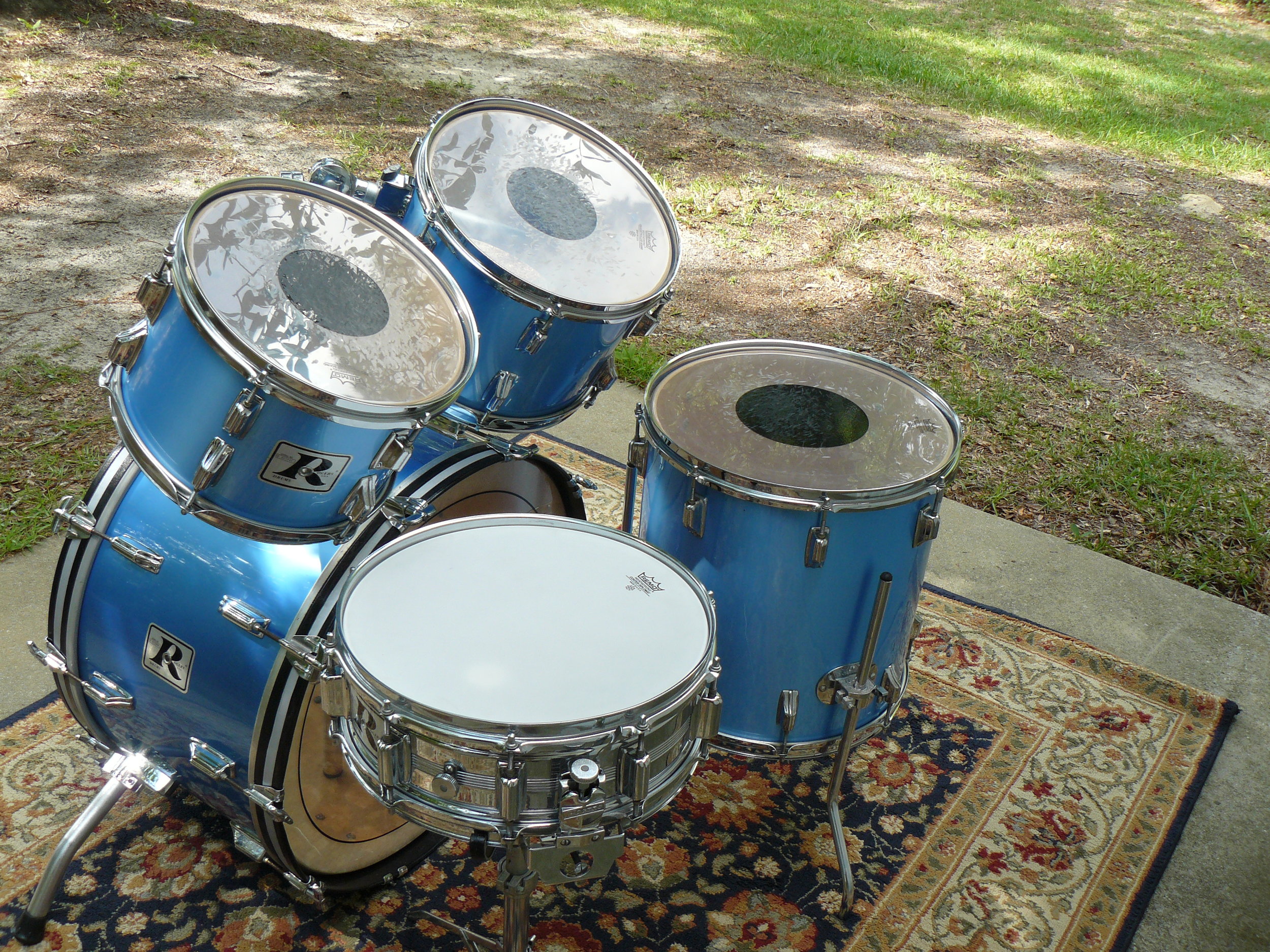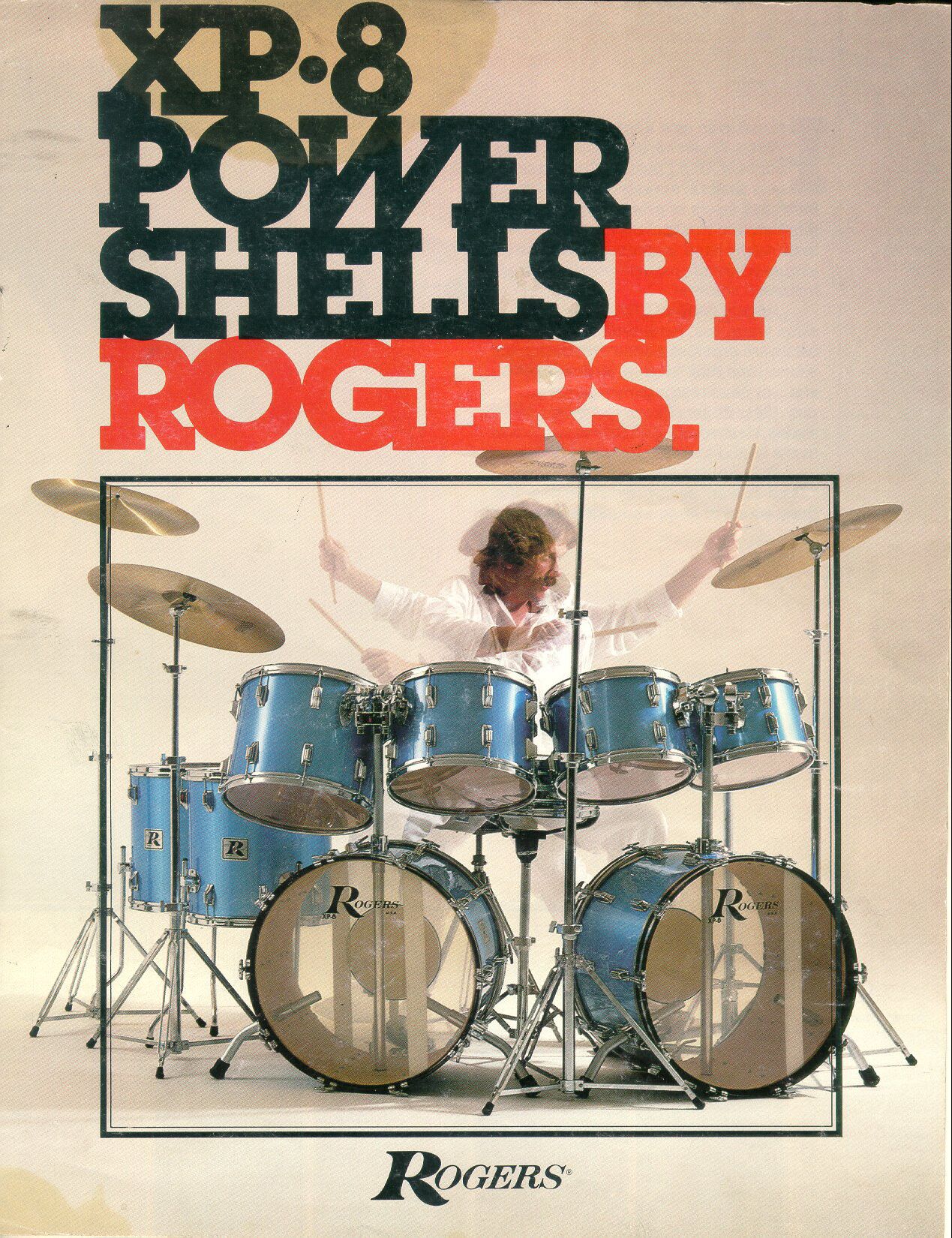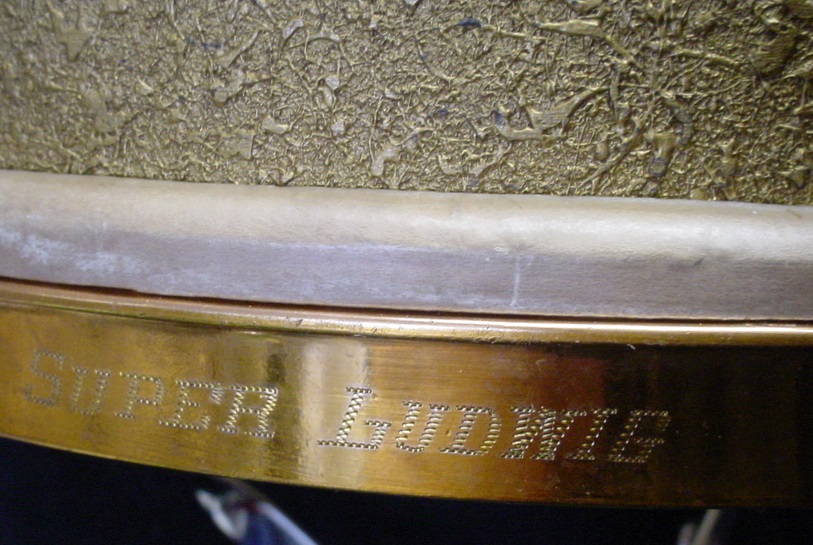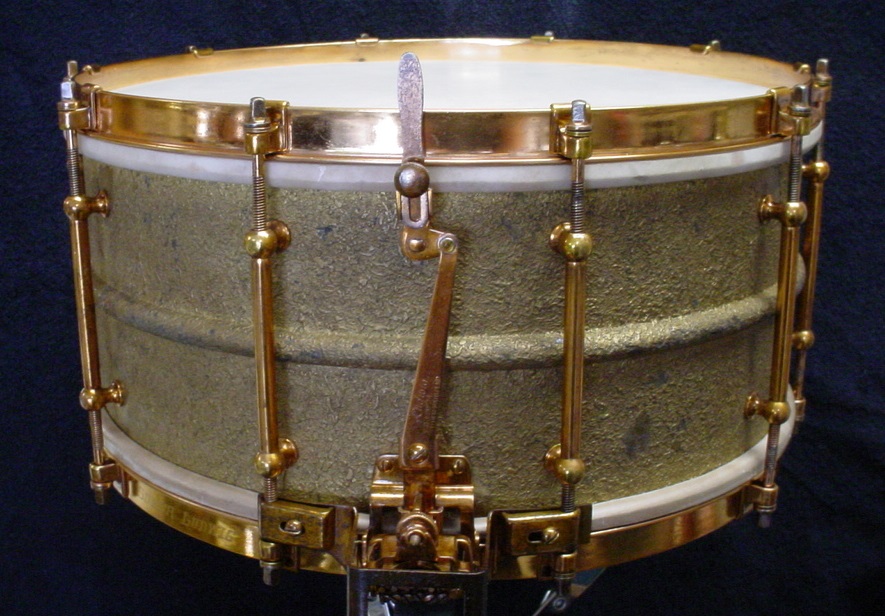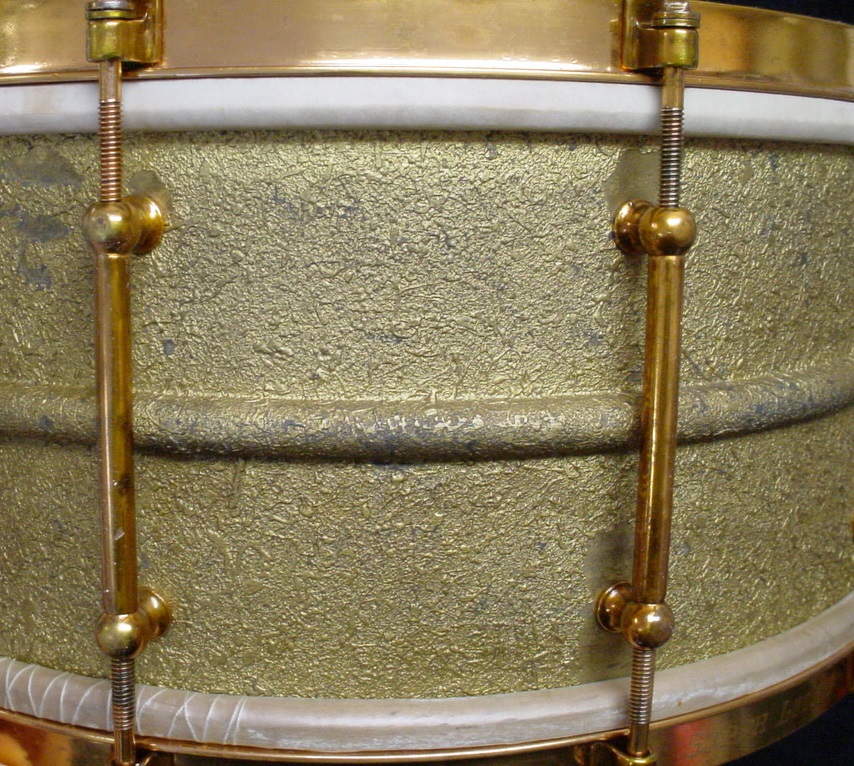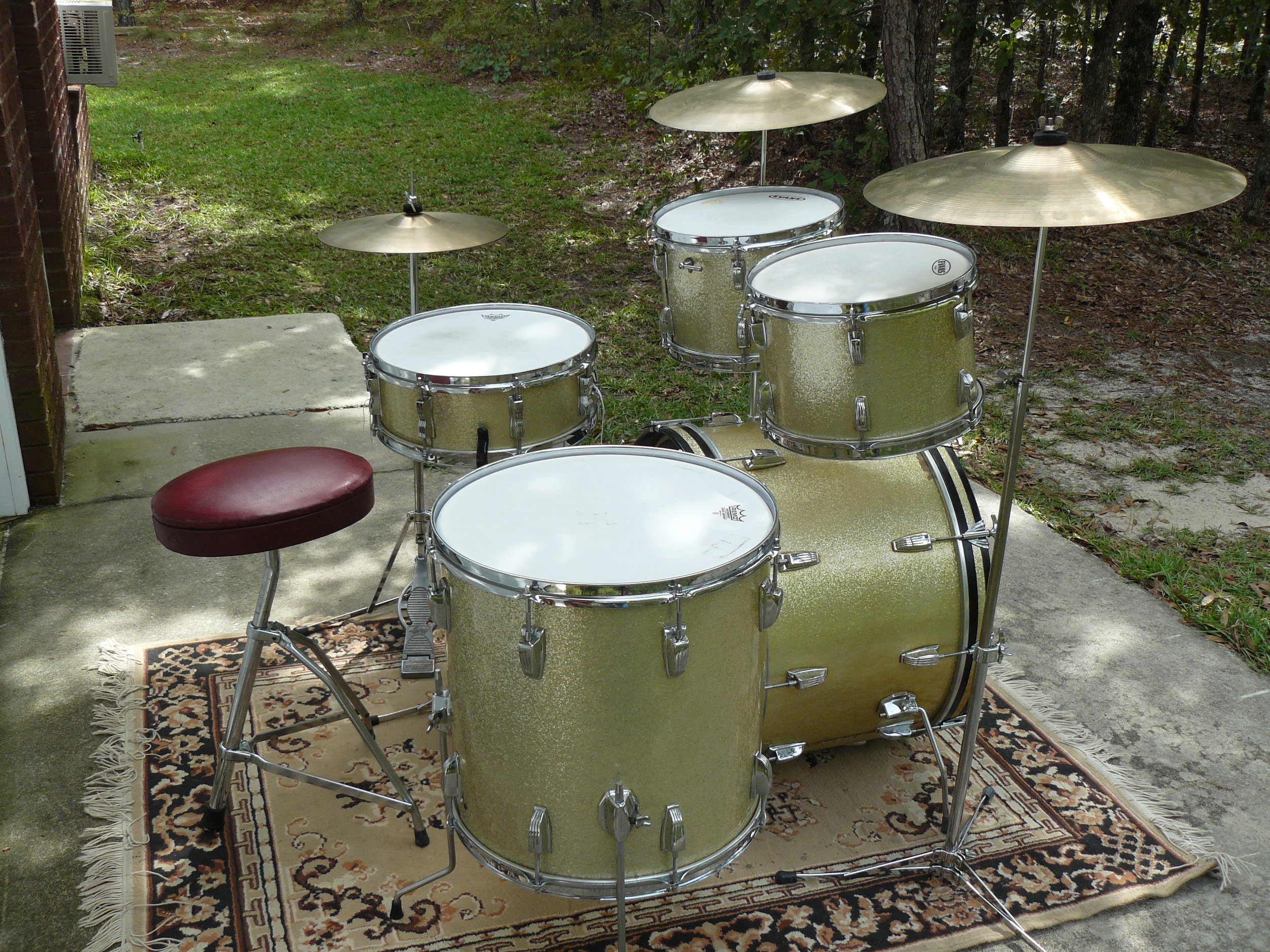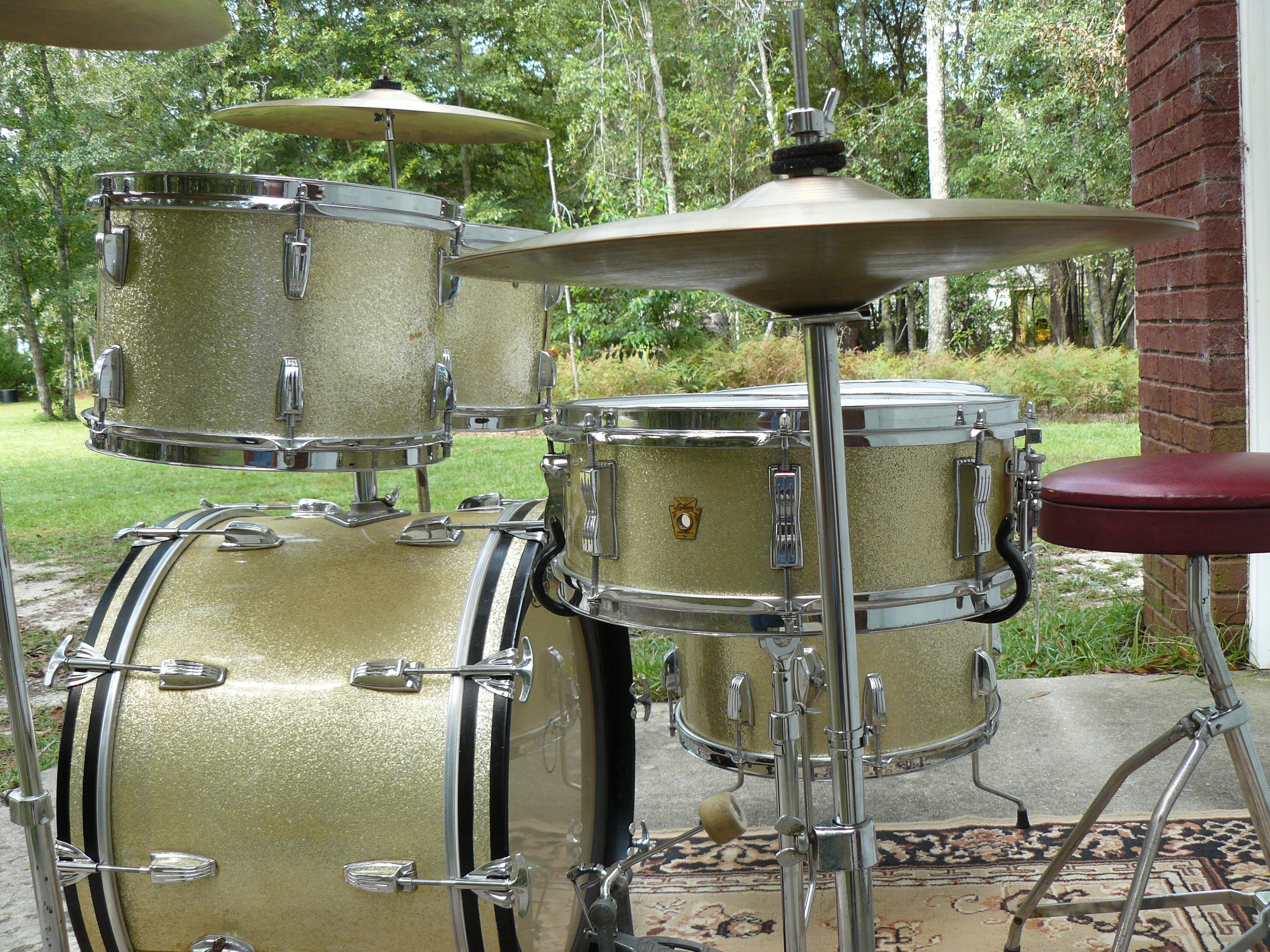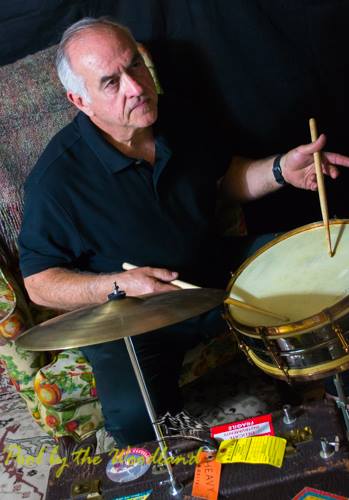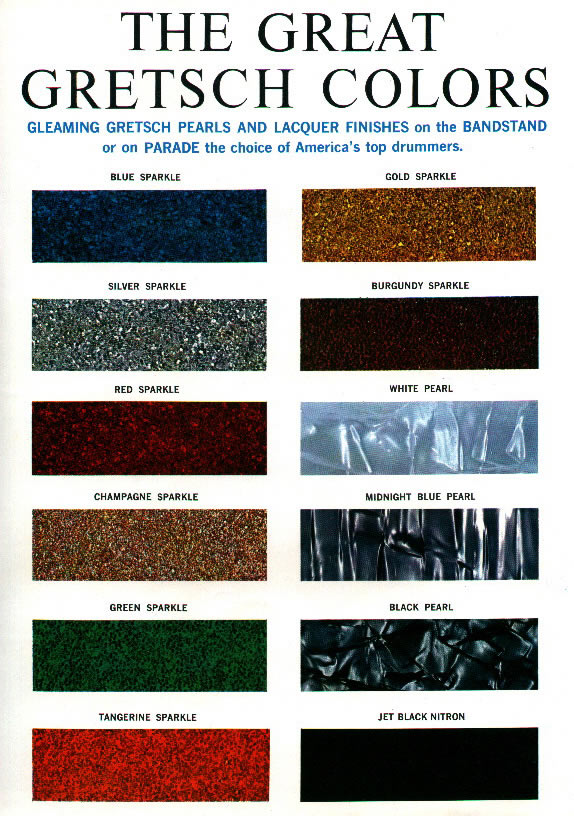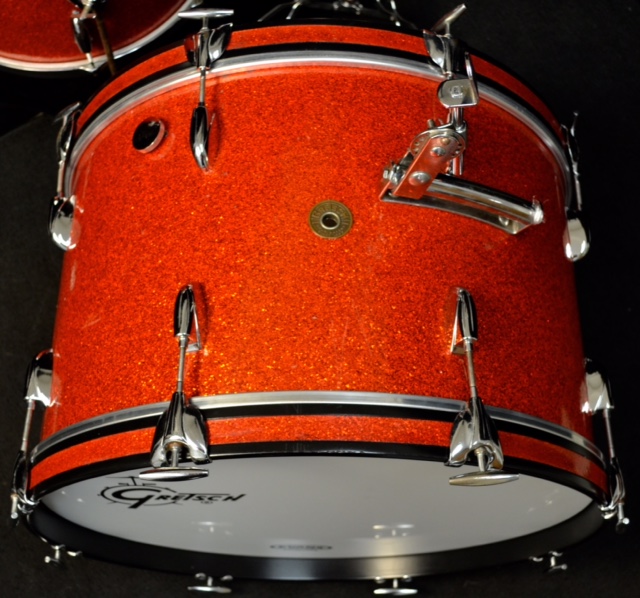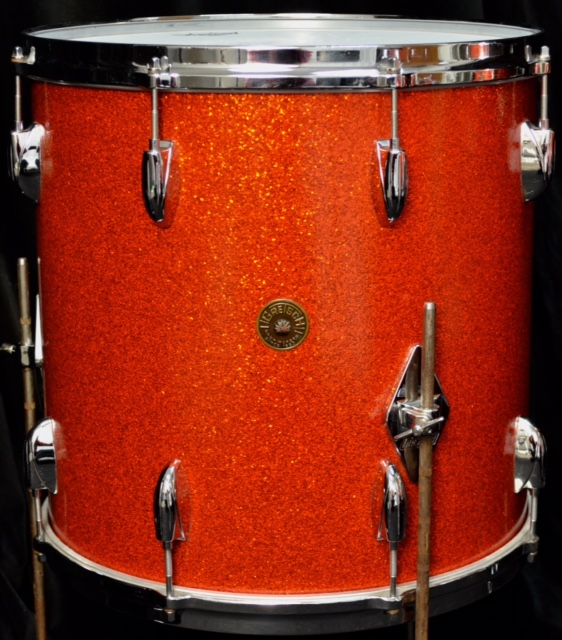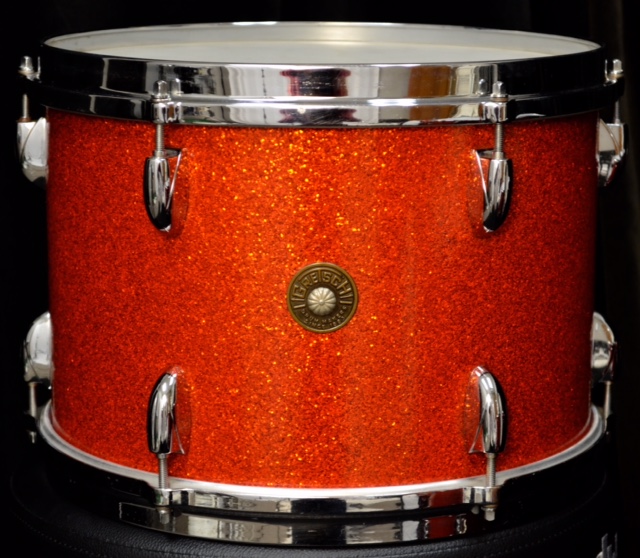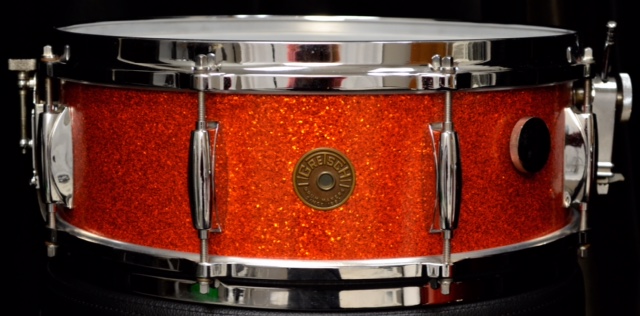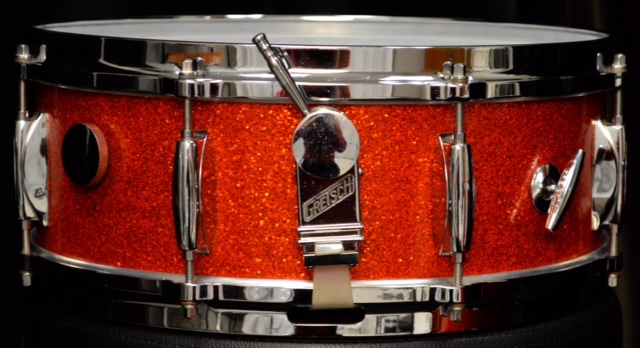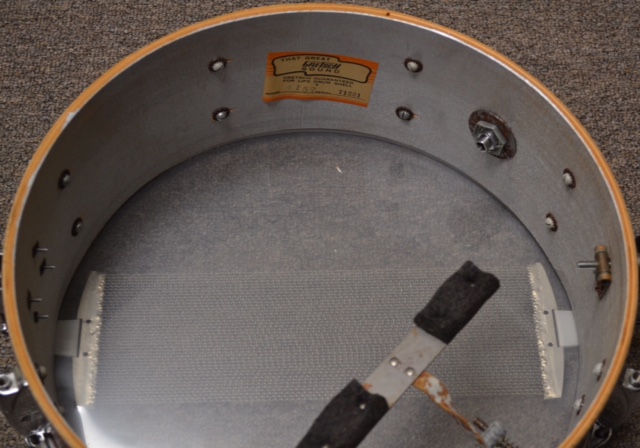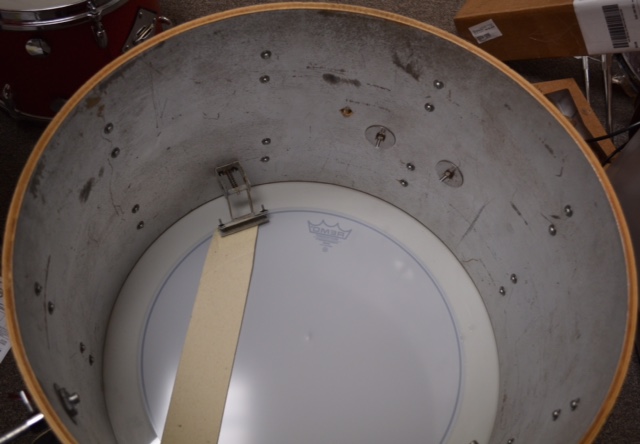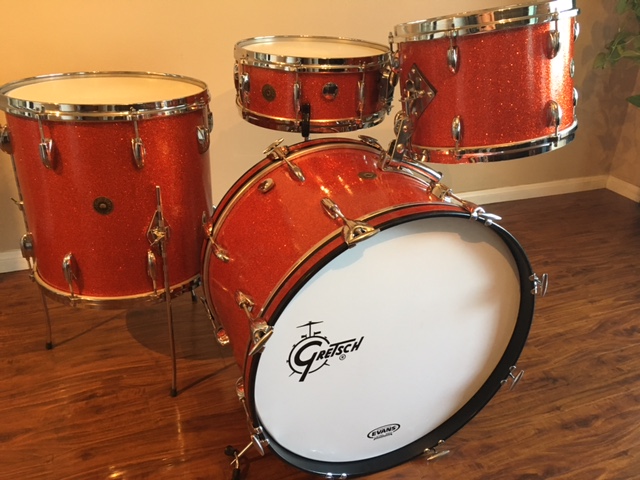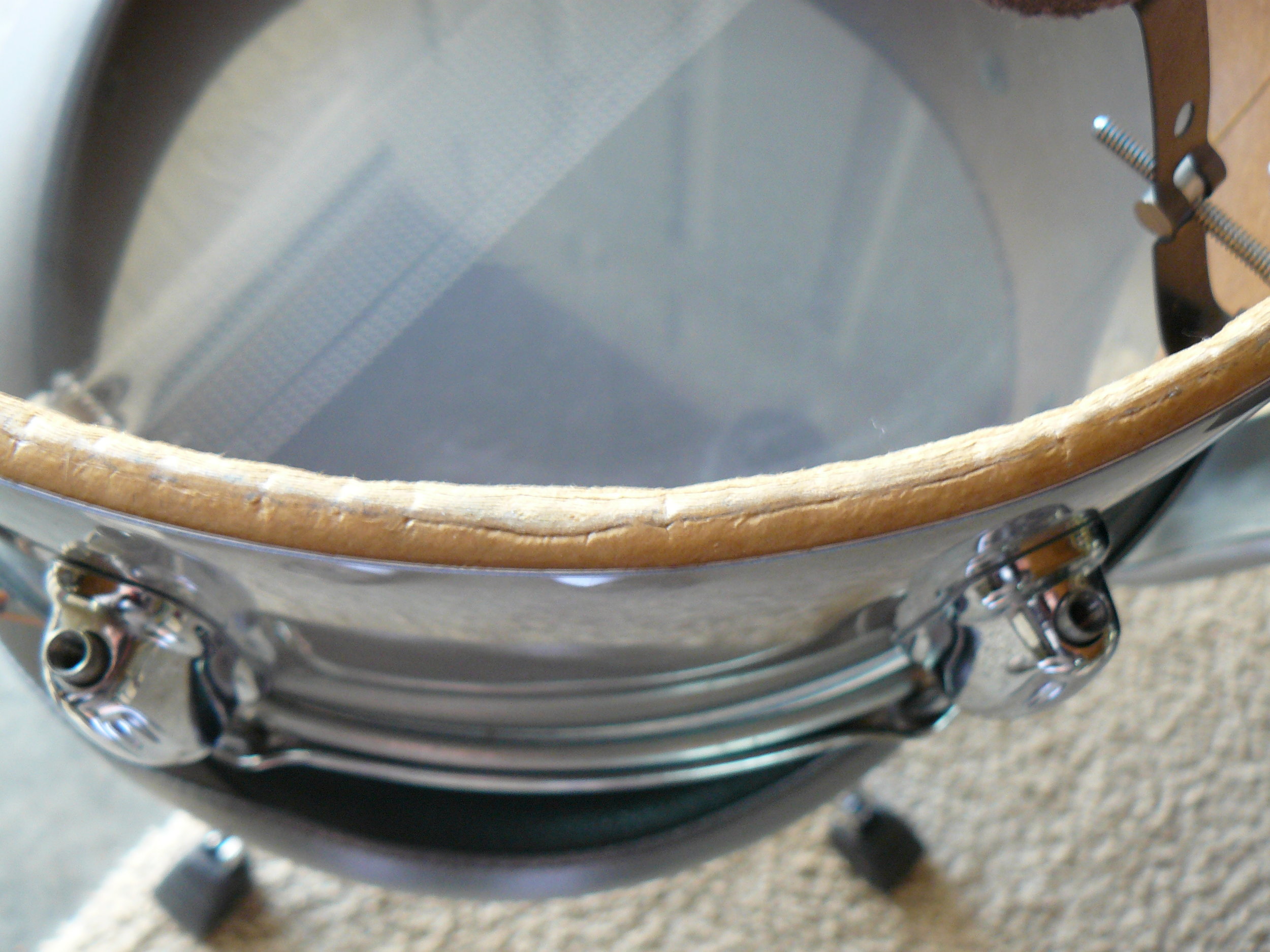In the aftermath of WWII, which had totally disrupted Conn's drum divisions, it was decided to combine Ludwig & Ludwig with Leedy, creating the Leedy & Ludwig drum company. This new division became operational in 1951. Conn decided to discontinue the unprofitable Leedy & Ludwig division four years later in 1955."
Read moreWhat's This Worth? Walberg & Auge 1910 - 1920 Natural Perforated Snare and Perfection Carry-All Bass Drum
Sent in by Bill Smith of Lafayette, La. He wants some opinions on the value of these drums before he decides if he wants to sell them. I will post contact information if and when he decides to sell. Please post your opinions in the comments below or email me george@georgesdrumshop.com. Jeremy Esposito at Walber & Auge has already passed on them because he has four of them already!
Read more1972 Gretsch Emerald Green drum set
One reason for buying these drums with the 24" bass drum is because my wife told me I needed to start playing a larger bass drum at my shows. I was so impressed that she even thought about my drums and let alone was interested enough to make a comment about drum sizes. I had in recent years played a lot of 20" bass drums. She said I needed to move up to a 24" or maybe a 26." I finally asked her what prompted her to suggest I play a larger bass drum? Was it to get more "boom" in the music? She replied, "no, it's just that you are getting so fat you look like a bear on a tricycle behind that small bass drum." Good thing she lets me buy drums. I'll let that one slide. Keep looking for those great vintage drumsOne reason for buying these drums with the 24" bass drum is because my wife told me I needed to start playing a larger bass drum at my shows. I was so impressed that she even thought about my drums and let alone was interested enough to make a comment about drum sizes. I had in recent years played a lot of 20" bass drums. She said I needed to move up to a 24" or maybe a 26." I finally asked her what prompted her to suggest I play a larger bass drum? Was it to get more "boom" in the music? She replied, "no, it's just that you are getting so fat you look like a bear on a tricycle behind that small bass drum." Good thing she lets me buy drums. I'll let that one slide. Keep looking for those great vintage drums
Read moreBrian Hill - Drums of War - video.
This video was sent to us by Michael Outlaw of Outlaw Drums: On the Ropes with Brian Hill. Brian talks about Charles W Bonner, civil war drummer, and William S. Tompkins, drum maker. Brian is an expert in drum history. He is full of interesting anecdotes and facts on historical drums. If you love history, you need to check this video out. Brian Hill explains why he is so passionate about the drums he brings to the Museum Series On The Ropes.p
Read moreWhat is this worth? 1957 WFL "Anniversary" three piece multi sparkle "Salesman" set
"My Dad's kit is stamped 1957 (snare); the added floor is stamped 1962 and is the only one with chrome plated hoops. It is really close to mint condition with original heads also in great shape. The other three pieces are in excellent condition as well - the sizes are so interesting. I found a 1957 WFL catalog and don't see the snare or tom sizes listed!Dad said his Dad took him to Biascos Music store for his 14th birthday. Dad was born in 43 so that adds up."
Read moreVideo Review: Remo Felt Tone heads
Lucas Aldridge and I finally got our hands on some Felt Tone Heads from Remo and they are the bomb. We put the FiberSkyn on the batter side and the hazy on the front, and used matching regular heads for comparison. Felts have been attached/glued to heads before. The difference here is that the felt is NOT adhered to the head but adhered to the plastic strip which holds it against the head. This plastic strip also continues on around the circumference of the head acting as a very narrow "zero Ring" similar to the Power Stroke heads.
Read more1929-30 Ludwig & Ludwig 6.5 x 14 NOB Standard-Sensitive Model
In 1929 Ludwig & Ludwig offered four new snare drum models that can be found in the Fall 1929 Ludwig Drummer Magazine. The new models were the Super-Sensitive, New Era-Sensitive, Super-Power and the Standard-Sensitive Model, the drum in this article. From what I have researched it looks like the Super-Sensitive Model was around from 1929 through 1936, whereas the New Era-Sensitive, Super-Power and Standard-Sensitive Models only lasted for 1-2 years (1929-30). Super-Sensitive Models are very collectible and somewhat rare in certain instances but the other three Sensitive Models are extremely rare and, in my opinion, highly collectible.
Read moreReview: Evans '56 Calftone Drum Head
I am always trying different heads on my modern and vintage snares, as this adds to the sound palette of each drum. I put a set of the Evans ’56 Calftone heads on my late 1990’s birch Premier Genista 5-piece kit (my primary gigging set-up)…and was not disappointed. It was like playing calfskin, but with a bit more focus, response and attack. I especially loved the low frequencies that came out of my 22” bass drum (EMAD Calftone) and 16” floor tom. I also put a 14” Evans ’56 Calftone on one of my 5 X 14”, 1920’s scroll-engraved Ludwig Black Beauties. I often get uneven responses across an old calfskin head. This was not the case with the Calftone; it was very consistent and sounded quite warm. So overall, I’m really digging these heads.
Read moreThe WFL Twin Strainer Snare
There are many great examples of Twin Strainer drums left in the world but the parts are extremely hard to find. WFL continued to offer many of the parts as replacements up until the early 50s but most of those drums then were considered dinosaurs compared to the current offerings. Finding the strainers is probably the toughest part as there is a right and left half of each version, chrome or nickel version, and a smaller size version for 5.5x14 drums. The second version of the throw-offs also have very fragile tips and many a drum can be found with the strainer tips broken off. Most of the drums were also outfitted with a 10 strand set of snares for one side and a set of six silk wound snares for the other side. Occasionally I have seen drums with gut snares as an option as well. Many of the twin snares I have come across are missing either one or both sets of snares and they can also be very hard to replace. Lots of things in the drumming world have changed since the late 30s/early 40s but these Twin Strainer drums bring a look, sound and a design that comes from an era of great invention. There are many great examples of Twin Strainer drums left in the world but the parts are extremely hard to find. WFL continued to offer many of the parts as replacements up until the early 50s but most of those drums then were considered dinosaurs compared to the current offerings. Finding the strainers is probably the toughest part as there is a right and left half of each version, chrome or nickel version, and a smaller size version for 5.5x14 drums. The second version of the throw-offs also have very fragile tips and many a drum can be found with the strainer tips broken off. Most of the drums were also outfitted with a 10 strand set of snares for one side and a set of six silk wound snares for the other side. Occasionally I have seen drums with gut snares as an option as well. Many of the twin snares I have come across are missing either one or both sets of snares and they can also be very hard to replace. Lots of things in the drumming world have changed since the late 30s/early 40s but these Twin Strainer drums bring a look, sound and a design that comes from an era of great invention.
Read moreRogers 1980 XP-8 Series
My featured drum set this month is a Rogers Big R Londoner 5 set from the 1980s. It has all maple 8 ply shells with clear interiors and no reinforcement rings. These drums were called XP-8 series because of the shells. I copied the following information from a Rogers discussion forum, "XP-8s have 8-ply rock maple shells and were made from 1979 up until the demise of Rogers in 1984. They're excellent quality and comparable to modern day DWs but can be had at a fraction of the cost. The Memriloc hardware is strong and sturdy and ensures that they'll set up exactly the same every time - a real time saver. These sets are battleship tough and built to last. XP-8s are some of the best drums Rogers ever produced."
Read moreBuddy Rich - As I Heard Him
I will say this: if Buddy could have read music he may have enjoyed staying in one place and making big money while staying in town (NY or LA) and being the house drummer for one of those late night tv shows. But (lucky for us) he had to move his band around a lot to keep it working all the time. This gave everybody, everywhere a chance to hear and enjoy Buddy Rich. (...and then again he probably wouldn’t have had it any other way)
Read moreFirst Generation Rescue of a Rogers Dyna-Sonic
Dyna-Sonic serial number 1171. This drum was offered on the Rogers Drums Group II Facebook page. Condition was utterly deplorable. The shell was covered in grime, many years worth of grime. It displayed the absolute worst in neglect. It was however, fairly complete. The frame, of course was long gone. The tension rods were mostly a mix of unknowns that were themselves thirty to forty years old. The heads on the drum, I am pretty sure, were 70s era Remo. This drum had not been played for decadesDyna-Sonic serial number 1171. This drum was offered on the Rogers Drums Group II Facebook page. Condition was utterly deplorable. The shell was covered in grime, many years worth of grime. It displayed the absolute worst in neglect. It was however, fairly complete. The frame, of course was long gone. The tension rods were mostly a mix of unknowns that were themselves thirty to forty years old. The heads on the drum, I am pretty sure, were 70s era Remo. This drum had not been played for decades
Read moreReinventing the Wheel: Racks and Remote Hats From A Century Ago?
So you think that state-of-the-art rack system you emptied your bank account for firmly puts you among the pinnacle of 22nd Century Drummers, right? After all, it is equipped with a remote cable Hi Hat, so it's the “Latest and Greatest.” Would you believe your great grandfather, the guy you got those drummin' genes from, beat you to the punch by nearly a hundred years?
Read moreHow Old Do You Think This Drum is?
????????
Read more1926-27 LUDWIG & LUDWIG 6.5 x 14 DeLUXE STIPELGOLD SUPER-LUDWIG MODEL
Ludwig introduced the new Stipelgold finish in their 1926 catalog. “The New Ludwig “STIPELGOLD” finish is a special composition producing a marvelous *“Stippled” effect in a bright golden hue. It is hard and durable, adhering tenaciously to the shell of metal or of wood.” The 1927 catalog introduces the “New Ludwigold Iridescent Display Finish”. It looks like the Stipelgold finish was short-lived, maybe 1-2 years. Aside from the 1926 catalog, the only other reference to the Stipelgold finish is at the bottom of the first page of the 1927 catalog: “LUDWIGOLD or STIPELGOLD at the same price.” So as best as I can tell by researching the 1926, 1927 catalogs and Rob Cook’s DRUM COLORS THE REBEATS COLOR SWATCH BOOK; Stipelgold was only around for one year, 1926.
Read moreSOLD: 1964 Ludwig Hollywood Set
Selling is a part of what I do. It is bittersweet to sell a kit, but it gives me joy to see someone else get a cool vintage drum set that they really like. I was a little bit sad to let this sweet Ludwig drum set go today. I had owned this 1965 Ludwig Hollywood set for a long time. I had a buyer come over today, and he was trying to get a great drum set to put in a music room he was building. One of my close friends told him to check with me before buying a kit. He called me and asked if I had any drums for sale? I assured him I had several nice drum sets that would be perfect for his new music room. I told him there was nothing wrong with getting a new drum set, and they would work just fine, but a vintage set would be better. What do you guys and gals think, isn't vintage better?
Read moreGretsch Name Band Outfit in Tangerine Sparkle finish.
This is my very first Gretsch set and I finally own a kit made in NYC - Brooklyn, as a matter of fact, during the heyday of round badge Gretsch drum manufacturing. This is one of the most beautiful drum sets I have ever seen. The kit can look yellow, gold, red and orange depending on the lighting. I personally think it looks best in plain daylight.
Read moreJohn Densmore's Mod - The hunt for the Ludwig mod orange kit he used with the Doors
It was not until the mid-2000s that while surfing online I saw a pic of Vince Treanor (Former Doors road manager) pictured with the 14” floor tom that I knew was John’s. It was sometime in early 2016 when I learned that the drum had changed hands and was now in the hands of a new owner. I was able to contact that owner and was happy to find that he was very friendly and even happier when I realized that the drum was not terribly far from me and that I could go see it. Along with the owner, we were able to look at close up pics of John using the drum in the 60s and match up the color striations to authenticate it as the original drum.
Read moreThe Rogers XP10 Series Snare Drums, 1981 - 1984 Dyna-Sonic and Super Ten
Shortly after the launch of the XP8, eight ply, all North American Maple shell ply series of drums in 1979, the reissue of the Rogers wood snare drum brought to us the XP10 series of snare drums. The production list of snare drums from 1965 had over a half a dozen various models. The production list for 1975 had two, Dyna-Sonic and SuperTen being the only offerings from Rogers. Available in 5x14 and 6.5x14. Dyna-Sonic was COB, SuperTen was COS. Rogers had discontinued wood shell snare drums in 1972, primarily due to lack of sales. The late 70's and early 80's, however, wood shell snare drums steadilly gaining in popularity. Into this market, Rogers launched the XP10.
Read more1980s Slingerland Foil Badge 100 Series snare drum, cardboard shell
"Slingerland shells reached a new low in the early 1980s when they actually sold drums which were little more than cardboard tubes with pearl covering and some hardware slapped on. The tubes were sturdier than the mailing-tube type, as they were actually made from Sonatube. (Sonatube is used for telescopes and as forms for casting concrete pillars.) The basic material was nevertheless cardboard, and the bearing edges quickly lost their integrity."
Read more




